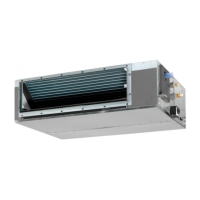A
45°±2°
φ 9.5
36.3 ± 3.6 13.0 ± 0.2
φ
12.7
54.9 ± 5.4 16.4 ± 0.2
φ
15.9
68.6 ± 6.8 19.5 ± 0.2
CAUTION
Do not have oil adhere to the screw part of resin
parts.
If oil adheres, it may weaken the strength of screwed part.
Do not tighten
nuts too tight.
If a flare nut cracks, the refrigerant may leak.
• If there is no torque wrench, use Table 3 as a rule of
thumb.
When tightening a
nut with a spanner harder and
harder, there is a point where the tightening torque sud-
denly increases.
From that position, tighten the nut additionally at the angle
shown in Table 3.
After the work is
check securely that there is no
gas leak.
If the nut is not tightened as instructed, it may cause slow
refrigerant leak and result in malfunction (such as does
not cool or heat).
Table 3
Piping size
(mm)
Tightening
angle
Recommended arm length of
tool used
φ 6.4 60° - 90° approx. 150 mm
φ 9.5 60° - 90° approx. 200 mm
φ 12.7 30° - 60° approx. 250 mm
φ 15.9 30° - 60° approx. 300 mm
CAUTION
Insulation of piping must be carried out up to the
connection inside the casing.
If the piping is exposed to the atmosphere, it may cause
sweating, burn due to touching the piping, electric shocks or
a fire due to the wiring touching the piping.
CAUTION
• Install the indoor unit leveled.
If the indoor unit is inclined and the drain piping side gets
high, it may cause malfunction of
switch and result in
water leakage.
• Attach nuts on the upper and lower side of hanger.
If there is no upper nut and the lower nut is over-tightened,
the hanger and the top plate will deform and cause abnormal
sound.
• Do not insert materials other than that
into
the clearance between the hanger and the washer for
hanger (11).
Unless the washers are properly attached, the hanging
bolts may come off from the hanger.
WARNING
The indoor unit must be securely installed on a place
that can withstand the mass.
If the strength is
the indoor unit may fall down
and cause injuries.
6. REFRIGERANT PIPING WORK
• For the outdoor unit refrigerant piping, refer to the installation
manual attached to the outdoor unit.
• Carry out insulation of both gas and liquid refrigerant piping
securely. If not insulated, it may cause water leakage. For
gas piping, use insulation material of which heat resistant
temperature is not less than 120°C.
For use under high humidity, strengthen the insulation
material for refrigerant piping. If not strengthened, the
surface of insulation material may sweat.
• Before installation work, make sure that the refrigerant
is R410A. (Unless the refrigerant is R410A, the nor mal
operation cannot be expected.)
CAUTION
This air conditioner is a dedicated model for new re-
frigerant R410A. Make sure to meet the require ments
shown below and carry out installation work.
• Use dedicated piping cutters and
tools for
R410A.
• When making a
connection, coat the inner
surface only with ether oil or ester oil.
• Use only the
nuts attached to the air conditioner.
If other
nuts are used, it may cause refrigerant
leakage.
• To prevent contamination or moisture from getting
into the piping, take measures such as pinch ing or
taping the pipings.
Do not mix substance other than the
refriger-
ant such as air into the refrigeration circuit.
If the refrigerant leaks during the work, ventilate the
room.
• The refrigerant is pre-charged in the outdoor unit.
• When connecting the pipings to the air conditioner, make
sure to use a spanner and a torque wrench as shown in
Fig. 9.
• For the dimension of
part and the tightening torque,
refer to the Table 2.
• When making a
connection, coat the inner
surface only with ether oil or ester oil.
(Refer to Fig. 10)
Then, turn the
nut 3 to 4 times with your hand and
screw in the nut.

